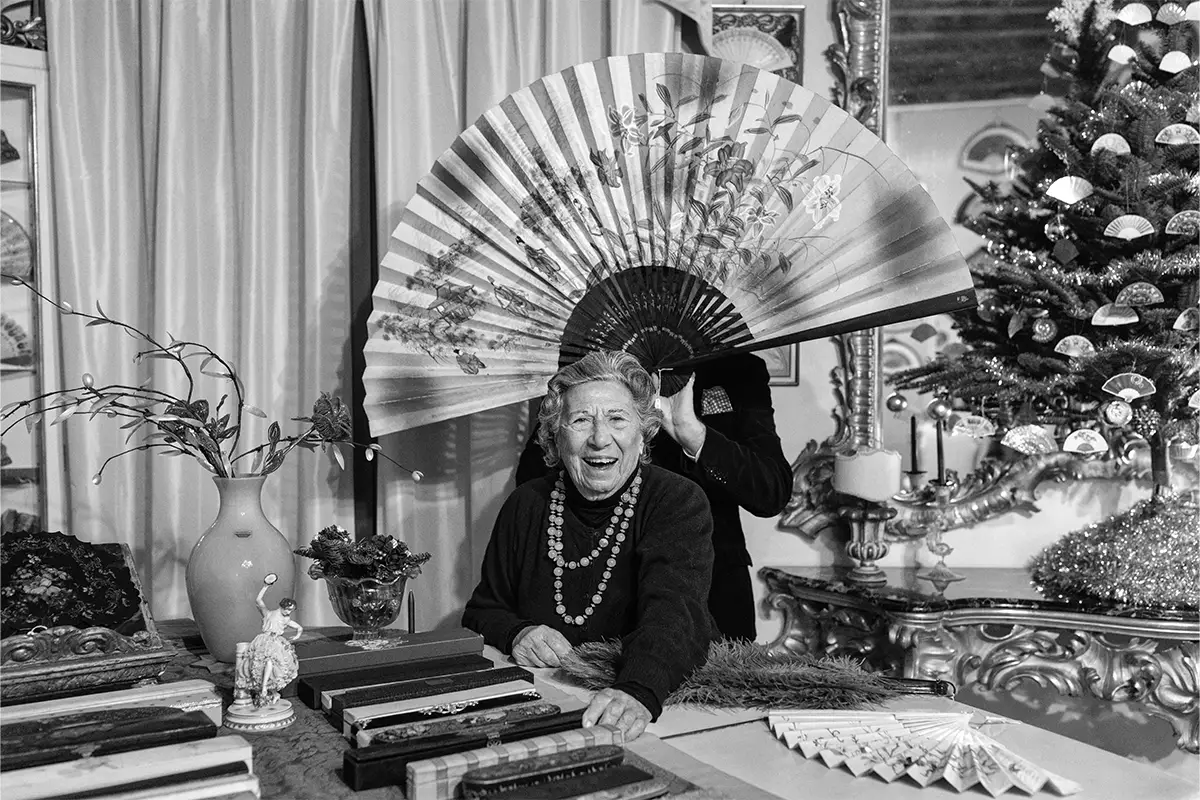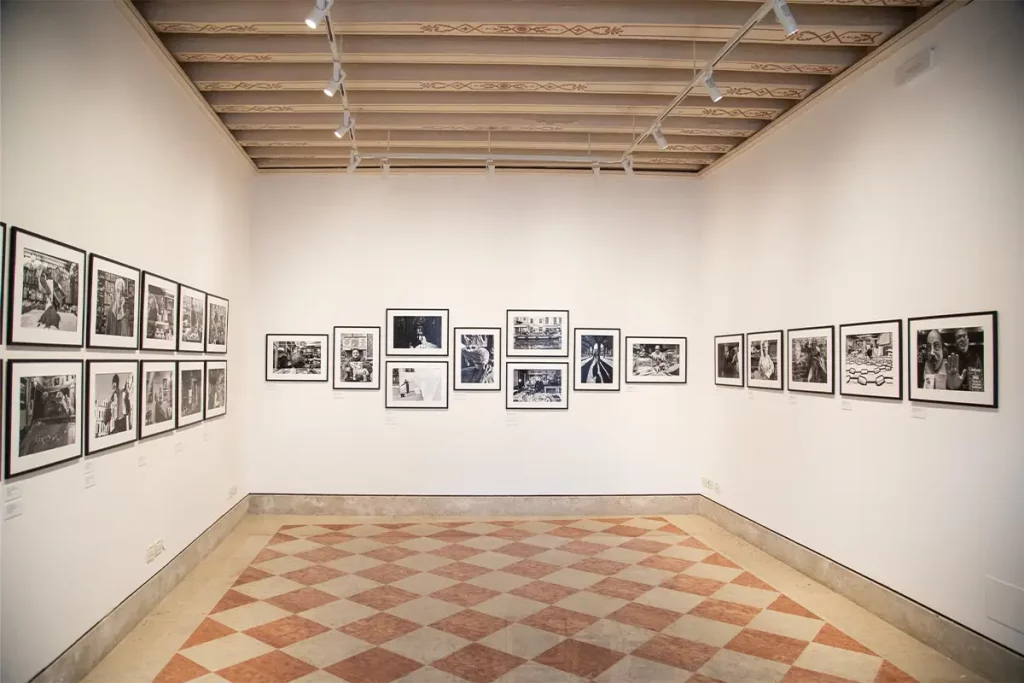Fondazione dell’Albero d’Oro hosts an exhibition by the Greek-French photographer Nikos Aliagas. Venice seen from the outside is all about respect and contamination
It is a cold winter day in Venice. If you walk to Campo San Polo, you will notice there is a big sign directing to a calle just behind the church. Following the arrows on the sign, get lost in the tangle of small, mostly unknown and often empty streets and walk to Nikos Aliagas exhibition at Palazzo Vendramin Grimani. During the quick walk, experience the suspension of time, put everything on hold, embrace the silence. Let yourself get lost, be outside of time and, in a sense, space.
Regards Vénitiens: Nikos Aliagas at Palazzo Vendramin Grimani
From February 4th to November 26th 2023, Fondazione dell’Albero d’Oro hosts an exhibition by the Greek-French fine art photographer Nikos Aliagas (Paris,1969). It covers more than four hundred square meters on the ground floor and in the courtyard of Palazzo Vendramin Grimani. The show, entitled «Nikos Aliagas. Regards Vénitiens», springs from a new artist-in-residence programme beginning in July and ending in December 2022, following 2021 Bosco Sodi, «What Goes Around Comes Back Around». Initially planned to be open until April 3rd, the exhibition closing was postponed to November 26th, meaning the Palazzo will remain open to the public with no interruptions for the whole season.
Black and white photography: a portrait
Aliagas only shoots in black and white, with his Canon EOS R3 Camera. As director, screenwriter and novelist Samuel Fuller once said, «life is color, but black and white is more realistic». Aliagas stands by this credo. And his pictures are full of life.
The perception of movement almost overcomes the nature of the medium. The scale of greys leaves room for imagination. Accustomed to an overflow of information, the viewer is drawn to Aliagas pictures because they have to look for life in them: becoming active.
Venice: the city shapes the project
Sometimes, the key element for taking a good picture can be letting life, letting the world around you overwhelm you: «I felt so small when I first got to Venice» Aliagas says, «what was I supposed to say to the people of Venice? Bonjour, I am going to show you your own city? Your history?». Venice can be just too much. Surely too large, too complex, too full of life to be captured in a photograph.
To face this issue, the photographer started from the immediate neighborhood, Campo San Polo, in the heart of Venice, investigating the lives of its residents and workers: passers-by walking their dogs, the local tobacconist and the waiter. Every detail contributes to painting the bigger picture. The essence of Venice is in small gestures and hidden glazes.
Starting from a question, reversing the narrative: Aliagas
Regards Vénitiens starts from a question: «I asked myself what more could be said about Venice». The city is most known for the Carnival, when tourists arrive in crowds – their phones and cameras in hand: «everybody comes to Venice to take pictures during the Carnival, to take selfies and see the famous city».
Venice is the sixth most photographed city in the world. Aliagas was looking for something different: «I was interested in those you do not see in Venice: the people who live here; the artisans; people who inhabit the ‘campi’». So it begun: «I started from the lady selling cigarettes, from the pastry chef».
Is it still possible to improvise in Venice? In a city photographed millions of times by as many passing eyes? «Yes» Aliagas replies, «if you take your cue from the fact that it is Venice that looks at us and observes us». A logic reversed. The image is fitting for such an eternal place. We all are passers-by; Venice, with her eyes on us, remains. The exhibition opened just in time for Carnival: a sound alternative to the endless stream of images.
Stealing or giving back? The photographer dilemma
People who visit Venice with a camera or a smartphone in their pocket – whether they are photographers or not does not really matter – are ready to become collectors of images for their or someone else’s gallery. It is no wonder that the verb for shooting is to take pictures. Not many visitors on the other hand are preoccupied with what they can give back to the city.
For Aliagas, it is different: «I wanted to give back. Give the photograph back to the subject I was shooting. I did not want to act as a mirror either, I wanted to give their image back to my subjects as someone who did not know them but was actually seeing them. Their tiredness, their enthusiasm, their solitude, their fierceness, and pride». When there is so much eternal beauty all around, it can be easy to forget about the human lives connected to it. Aliagas never makes this mistake.
He observes the locals, not just through the lens, but seeing their human side too: «all of this is almost heavy to live – people from Venice are tied to the city but at the same time are European citizens living in the XXI century». Inhabiting a constant dichotomy.
Showing the unseen: or reading between the lines
Aliagas always has the same approach when starting a project: «when I travel and take pictures, I like reading between the lines – to show what is normally unseen. Above all with humbleness. What I was looking for in each of the eyes I photographed is their singularity». In the digital age everything is shown – or shown off. You can find a picture of anything and see everything from a screen. It is almost compulsive.
Obsessed by seeing and being seen. The opposite is more intriguing: trying to see what is not immediately apparent. One of the pictures in the first room shows a fan’s atelier with a woman smiling at the camera. The meaningful relationship between subject and photographer is immediately apparent.
There is more: what makes the picture interesting is what stands behind. A man stands behind the subject, his face hidden behind an immense fan. Behind the subject’s smile itself, a story is hidden. Everyone can take a picture, but it is not common to give the viewer a story to imagine.
The counterpart: architecture
The architecture of Venice can never be forgotten: «Venice itself is a theatre, an open-air scenography. The great architecture cannot be ignored, just like the fact that some of the greatest pictures of the history of photography were shot in Venice».
Counterpart to the portraits are the photographs of the city. Upon entrance on the right, the first picture: a welcome to Venice. It looks like a drone shot but was taken by Aliagas from the plane with his camera. The lagoon is immense and benevolent. A series of bricole seems to be welcoming the photographer with open arms.
A good auspice. The city is plastic, ever present impossible to ignore. Just as its relationship with water. Aliagas captures the vastness of water but also reflections, and rain. The centuries weighing on the shoulders of Venice melt, finding a mitigating companion in the clarity of water.
Time: freezing it, moving it forward
«Time is very paradoxical in Venice. It seems like it stopped in a way, but everything runs fast». Whether he is aware of it or not, Aliagas pictures live the same paradox. Photographs are made to freeze a moment in time, to capture and seize.
Aliagas stops the motion of daily life, to give birth to a new one. The image is frozen just so that viewers can start making up their own stories, setting in motion their imagination. The use of black and white also contributes to giving the pictures an atmosphere of eternity. Yet time runs wild in the life of those who are photographed: «Venice won’t wait for you».
Art and crafts: captured by Aliagas
Aliagas also dedicates a large section of the solo exhibition to the arts and crafts of Venice. From Caffé Florian to Lo Squero di San Trovaso, the most iconic and traditional sites of Venice fit in the show. Once again, details make all the difference. Hands, glazes, corners, window shops. All but the typical Venice aesthetic. People are at the heart of Aliagas’ pictures even when they are not in the frame. Protagonist is the local knowledge, ancient and contemporary.
«There is a very strong sense of local culture and at the same time people live in simplicity», perhaps simplicity is what stands at the core of venetian culture: a way of being. Venice is not rejecting either. Since its origins, the city does more than just welcoming foreigners: it bewitches and captures them. Thirsty for differences. The influxes from an infinite number of cultures are apparent. Yet it maintains its peculiar identity. The magic is made possible: «you can also become a Venetian: people who embrace the way of life are accepted».
Nikos Aliagas
Greek-French journalist, TV and radio host and photographer. Born to Greek parents, Nikos Aliagas became a French national at the age of 18. After graduating in Modern Literature from the Sorbonne, he worked forRF Iand Radio Notre-Dame before joining Euronews.




















